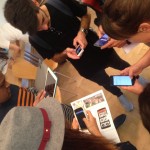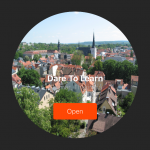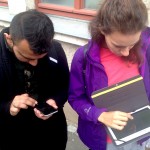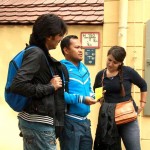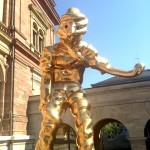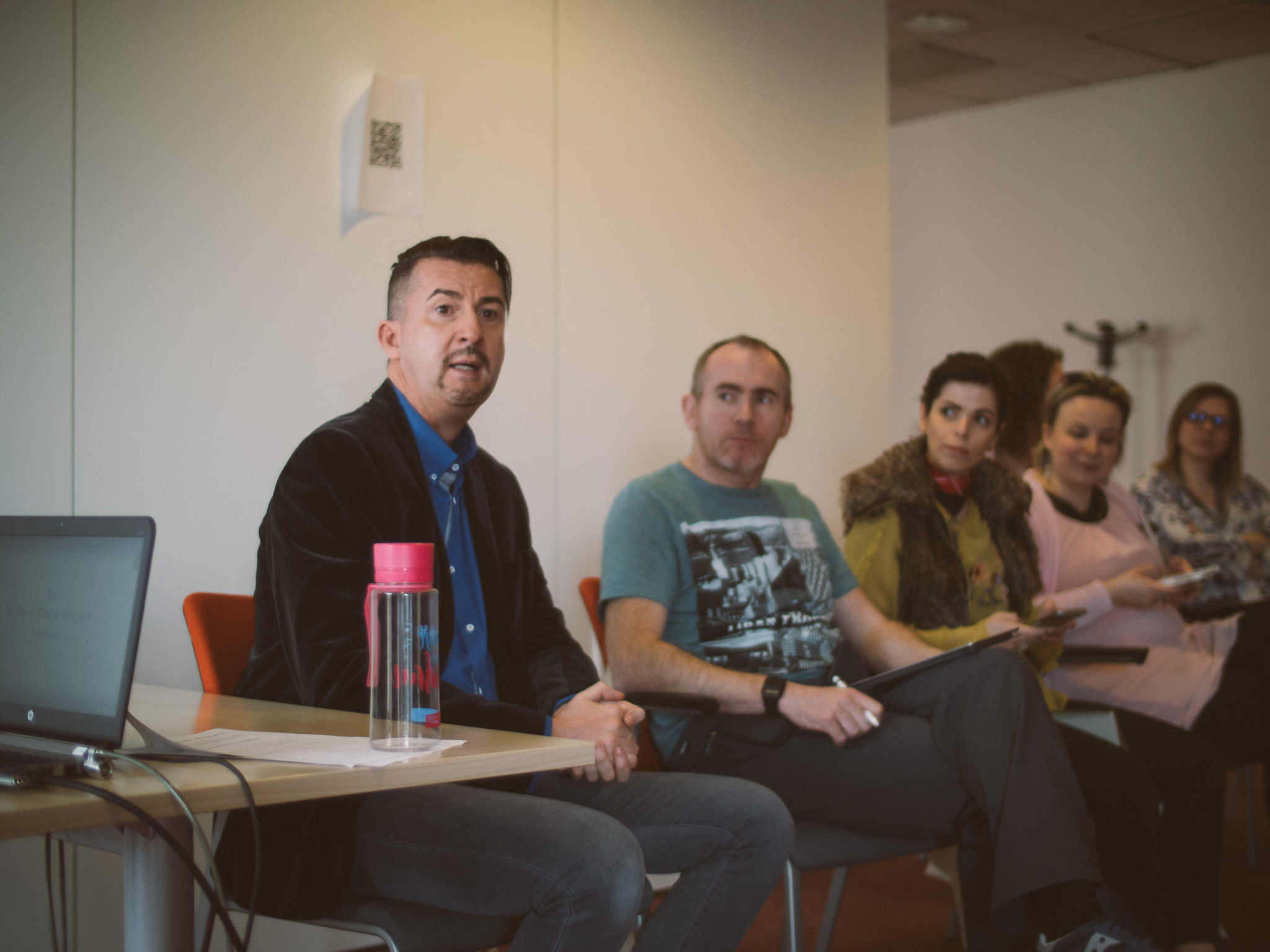Next Urban Adventure is Just Around the Corner
 You work with young people in urban environment and want to create a learning experience that is exciting, happening outdoors and uses digital technologies? With ‘Expedition’ you can make the usual and familiar urban environment a base for unusual learning experiences.
You work with young people in urban environment and want to create a learning experience that is exciting, happening outdoors and uses digital technologies? With ‘Expedition’ you can make the usual and familiar urban environment a base for unusual learning experiences.
20 people from 11 countries (Italy, Romania, Greece, Turkey, Pakistan, Bangladesh, Philippines, USA, Germany, Slovenia and Lithuania) met in Weimar to explore and adapt the ‘Expedition’ learning framework for urban environment. Earlier this year a training course took place in Lithuania, where this learning framework was presented and tested for rural environment.
The outcome of this course are insights and guidelines, how to create your own expedition. We want to share them with you.
First of all, what is an expedition?
One of the inspirations come from the great masterpiece, book by A.A.Milne about Winnie-The-Pooh:
“We are all going on an Expedition,” said Christopher Robin, as he got up and brushed himself. “Thank you, Pooh.”
“Going on an Expotition?” said Pooh eagerly. “I don’t think I’ve ever been on one of those. Where are we going to on this Expotition?”
“Expedition, silly old Bear. It’s got an ‘x’ in it.”
“Oh!” said Pooh. “I know.” But he didn’t really.
“We’re going to discover the North Pole.”
“Oh!” said Pooh again. “What is the North Pole?” he asked.
“It’s just a thing you discover,” said Christopher Robin carelessly, not being quite sure himself.
“Oh! I see,” said Pooh. “Are bears any good at discovering it?”
“Of course they are. And Rabbit and Kanga and all of you. It’s an Expedition. That’s what an Expedition means. A long line of everybody. You’d better tell the others to get ready, while I see if my gun’s all right. And we must all bring Provisions.”
(c) A.A. Milne “Winnie-the-Pooh”, 1926; Drawing by E.H. Shepard, 1926
So, the line of everybody!
Expedition for us means that you learn through a combination of methods embedded in a learning framework or a learning “playlist”, that has a strong ingredient of adventure within learning experience. Such learning creates unexpected situations, has planned and unplanned challenges, includes surprises and accepts uncertainty.
We look at our environment not as a random given condition or distraction (as it is for example with exciting cities), but as a rich learning space, be it urban or rural. We design learning with any environment, creating opportunities for people to roam the city in the group, however learning according to each individual’s personal challenges and inclinations.
During “Expedition” you have a perfect situation where the group follows the instructions of a customized app (we used Actionbound and Klikaklu, but can be any other app serving the purpose). Each individual can decide within the ‘Expedition’ what aspects and how profoundly they want to learn about and from specific locations included in their ‘mission’. Within given time boundaries (in our case it was 2 – 5 hours) the group can flexibly steer their activities. They can choose how many locations they want to reach, how long to explore every location or given task, when and where to have a break.
Given the fact that Weimar is full of exciting tourist attractions, we deliberately chose locations and objects that are outside of usual tourist routes. For us it was not important that people learn about the facts of famous people and buildings in the city. The important thing was to awaken individual curiosity for surroundings through skilfully posed questions and tasks to explore what could be the answer. Being in the group gave the chance to exchange ideas with other participants, resulting in rich learning experiences while having fun.
Here is one example
 We asked a question about the purpose of a building on the edge of the town that sported various animal heads. The natural but not obvious clue in the environment was the name of the street in German language: Schlachthofstr. (it means the street of the butcher). The question made the group exchange their ideas about their own hypothesis. They investigated their surroundings, asked the locals for their opinion.
We asked a question about the purpose of a building on the edge of the town that sported various animal heads. The natural but not obvious clue in the environment was the name of the street in German language: Schlachthofstr. (it means the street of the butcher). The question made the group exchange their ideas about their own hypothesis. They investigated their surroundings, asked the locals for their opinion.
In this case participants did not find the clue, but their ‘mission’ lead them to other discussions, that were indirectly related to the building. And exactly that was the point! People could talk and exchange their individual ideas about what was important to them in that particular situation. Having a group from such diverse cultural backgrounds gave an opportunity to learn about various ‘random’ things. So here you can see – in expedition participants can follow their own ‘learning bliss’!
Education in many parts of the world is infested by control mania. We pursue exactly the opposite. We trust that people are naturally curious beings and our job as educators is to invoke curiosity and provide learning settings.
Along the lines of the movement of Connected Learning we identify and connect learning opportunities in the given environment, be it urban or rural. We use digital technology to create meaningful learning programmes or ‘playlists’ to encourage and capture learning. A ‘playlist’ is “a curated group of learning experiences stitched together into a compelling, media-rich narrative around a common theme. Playlists are organized around passions and competencies.” (LRNG) Learning is thus tailored to a huge extent by the learner herself.
So, how to design an ‘Expedition’?
1. Scout out your environment / develop the idea
We do not want to tell people about things or places. Tourist guides already do that. Wha t we want is to provide a setting where people can learn by themselves guiding their learning process themselves. So, in order to create a setting first of all we just roamed the environment, perceiving not obvious details – a spot under the bridge with brilliant acoustics, a wall full of graffiti, a phrase on a building, etc. We found places and objects that are not conventional attractions, but where you could see and learn something interesting – such as about ginkgo trees, Bauhaus architecture details, a hidden bar, a shiny mysterious huge cube that hides electricity installments.
t we want is to provide a setting where people can learn by themselves guiding their learning process themselves. So, in order to create a setting first of all we just roamed the environment, perceiving not obvious details – a spot under the bridge with brilliant acoustics, a wall full of graffiti, a phrase on a building, etc. We found places and objects that are not conventional attractions, but where you could see and learn something interesting – such as about ginkgo trees, Bauhaus architecture details, a hidden bar, a shiny mysterious huge cube that hides electricity installments.
2. Design the expedition
Now you want to make a story, a mission out of all these details. What do you think your target group is interested in? What would they like to learn? It is good to think of these questions first!
In Weimar we wanted the participants to give an opportunity to learn about Weimar how it is today, giving some hints to find out about its history from experiential perspective. Thus we guided participants to a building that accommodated a hidden bar, to a place where big gatherings of nazis used to take place and just let them listen to the recording of Hitler’s speech, park spot where great pianist Franz Liszt used to hang out just embedding a task to listen to a track of music with no indication to the name of the artist. We did not give any further explanations, but just provided the experience of space and the sound, thus invoking curiosity. Also we wanted our participants to interact with the local people and leave their comfort zone by accomplishing various tasks in the public. So, we embedded tasks, where participants had to find certain questions or overcome some obstacles interacting with people in Weimar.
3. Test it yourself, make adjustments
When you are clear about your idea, you can use on of the app to design the experience. There are plenty mobile apps to create a citybound, scavenger hunt, or photo hunt experiences. Just search for the one that fits your ideas. But then it is important to test it! Do not assume that it will work fine! Sometimes the GPS coordinates are being read differently with different devices. Sometimes pictures cannot be recognized as in Klikaklu, because of different light settings when you took the photo and when participants took it. Sometimes some failures happen because of interrupted internet connection. So – test, test, test!
Although Expedition as a learning framework was extensively discussed and practiced in the previous course in the rural area of Lithuania, it was really interesting for me to test it also in urban setting. Experiencing it myself in Weimar, I discovered so many possible applications of Adventures in city. I felt like reading the same pages of a book after some time and find so different interpretations! Fotini Komninou
Being a ‘ghost’
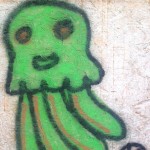 You might want to follow your group during the Expedition and observe how everything is going on. We called this role ‘being a ghost’.
You might want to follow your group during the Expedition and observe how everything is going on. We called this role ‘being a ghost’.
As a ‘ghost’ you are not participating in activities of the Expedition, but you are actively interested in the process. Sometimes you might find that your app is not working properly. Being with a group you can make adjustments. You do not want to be a teacher, but rather witness in people’s discoveries!
When taking the role of a ghost:
- Do not teach, let people to discover
- Be present with a group
- Show genuine interest
- Consider which questions to answer
- Try to understand, do not rush with conclusions
Learning from experience
Experience is good. But in non-formal learning you want to talk about it and understand the learning points in order to extract full potential of learning experience. For that we use debriefing.
In educational context debriefing is a guided exchange of observations, feelings and learning insights in the group. If you have full attention of the group and facilitate the process according to a certain structure, it can become a powerful source of learning, where members of the group can benefit of other members contributions.
We suggest you to structure debriefing according to these questions:
- What did you observe?
Ask the question, let people share who wants to share, then close the round and then start with the next question.
- How did you feel?
- What did you learn?
- Do you have any suggestions?
Some important moments to keep in mind during debriefing.
- Let everybody speak out
- Do not judge
- First listen
- Facilitate and stick to questions avoiding talking about everything at the same time
- Start sentences with “I feel / think… “ and not: “You are…. “
- Any suggestions, how to improve your product/Expedition/mission?
- What to take into real life?
In one of the last steps of the debriefing we asked participants to develop ‘Golden rules’ for designing expeditions in urban environment. Here they are!
‘Golden Rules’ for the design of Expeditions
- Design your expedition around a theme or topic that is of interest for participants

- Use expedition as learning tool, plan and facilitate debriefing after
- Create tasks and questions that would be creative, funny, interactive, tangible, flexible, reflective
- Don’t think as a developer, get into the shoes of players
- Plan reasonable duration for expedition, manage preparation and debriefing time well
- Test expedition on different devices, double check GPS coordinates
- Build expedition in team: scout together, decide together, plan together, share the work
- Work on plan A, but consider plan B
- Enjoy the process
By the end of our course we experienced an explosion of ideas how Expeditions can be used in different urban and rural contexts. Have a look at this list, where Expeditions can be of great use!
- To learn about the plants in the national parks
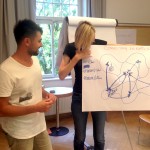
- To learn about city apartment buildings and involve people in urban planning
- To learn about city’s diverse multicultural backgrounds
- To increase communication between people from neighborhoods
- To use as a tool during youth exchanges about sport and music
- To connect teachers and students in one team and increase understanding between two groups
- To provide create for children to learn more about their own city while engaging parents as learners
- To learn about places in the city where famous movies were shot
- To use for participatory research and youth policy development, make expeditions to collect data
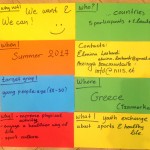
- Promote specific academic studies
- To teach mathematics using buildings and other objects of the city during an expedition
- To create touristic guide for history, theater, unknown places in the city, traditional cafes, sports in nature for locals
- To use as a tool in a youth exchange for participants to learn how to adapt in the nature and develop survival skills
- To use in Erasmus exchanges – instead of tour guides
- To use in mountain expeditions
- To use for social tour in in the city, to spend free time in the evening, with a reward system included
- To learn English in rural areas
If you think that any of the above ideas for expedition interests you and you would like to cooperate in hosting a training activity about expedition, contact us!
Evelina Taunytė NGO (taunyte@gmail.com)
Nerijus Kriaučiūnas, NGO Nectarus (info@nectarus.lt)
This article is an outcome of the training course “Expedition – Designing Adventures in Urban Environment” which was organised in September 2016, in Weimar, Germany. First part of this project took place in Lithuania in May 2016: “Expedition – Designing Adventures in Rural Environment”. This project involved youth leaders, youth workers and educators from 9 European countries. Applicant organisation: Culture Goes Europe, Sociocultural Initiative Erfurt E.v.

